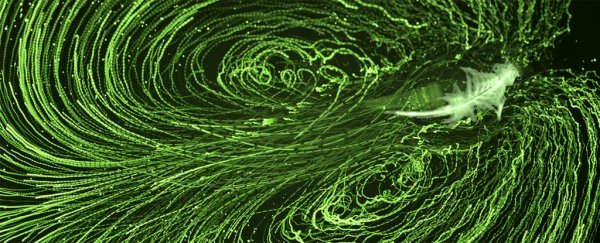In chaos theory, they say the infinitesimal flapping of a butterfly's wings can hypothetically cascade into a fierce tornado.
Now, scientists have demonstrated how some of the smallest creatures in the ocean could have the same outsized impact under the waves – with swarms of marine organisms inadvertently producing powerful currents that mix and churn a turbulent undersea environment.
"Swimming animals could play a significant role in ocean mixing – an idea that has been almost heretical in oceanography," explains fluid mechanics engineer John Dabiri from Stanford University.
"Right now a lot of our ocean climate models don't include the effect of animals, or if they do it's as passive participants in the process."
The thinking behind that exclusion is understandable.
After all, the kinds of creatures Dabiri's team investigated in their new research – brine shrimp – are so small they're basically underwater insects, famously sold in yesteryear's comic books as the novelty aquarium pets, Sea-Monkeys.
How could these insignificant zooplankton churn the ocean blue?
Strength in numbers, it turns out, as swarms of the creatures migrate daily in vertical columns, feeding at the ocean surface by night, before retreating hundreds of metres deep by day.
"You have this massive migration vertically every day of literally trillions of organisms," Dabiri told NPR.
"As they start swimming upward, each of them kicks a little bit of fluid backward… pretty soon you have this vertical stampede upward of these shrimp, and [the water is] getting rushed downward by this successive series of kicks."
To measure the effects of this snowball effect, the team placed brine shrimp in vertical tanks filled with salt water, and induced the animals' day/night migrations up and down via lights mimicking the rise and fall of sunlight.
The researchers then filmed the water flow with the aid of dyes and tiny glass beads to help them visualise the strength of the eddies the swarms generated.
From their footage, the team discovered the animals' passing didn't just distribute water in small, localised regions, but churned significant volumes of proxy ocean pretty much everywhere they went.
"They weren't just displacing fluid that then returned to its original location," one of the team, Isabel Houghton, explains.
"Everything mixed irreversibly."
So far, these effects have only been demonstrated in the lab, but if the same thing is taking place out in the real world, biologists and oceanographers will need to rethink how marine life contributes to ocean turbulence – especially since the same thing could be happening with bigger animals, such as jellyfish, squid, fish, and even large mammals.
Unlike the metaphor of the butterfly wings producing a twister on the other side of the planet, though, the churning effects probably won't capsize your next ocean cruise.
But they could have a significant impact on how we assess phenomena like nutrient transport underwater, and how things like carbon dioxide get distributed underwater and released to the atmosphere – and all because when life forms come together, we're stronger because of it.
Even if you're just a 1-centimetre-long Sea-Monkey.
"Previous studies looked for turbulence or eddies on the scale of the animals' size," Dabiri told Science News.
"This paper tells us for the first time what to look for."
The findings are reported in Nature.
